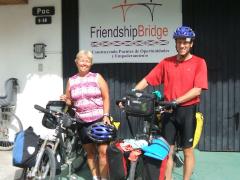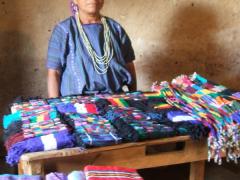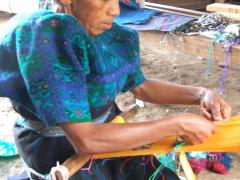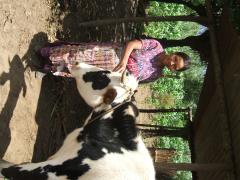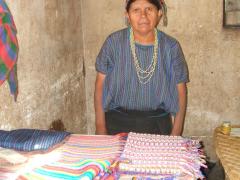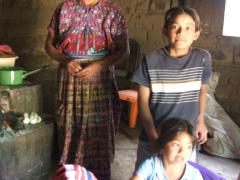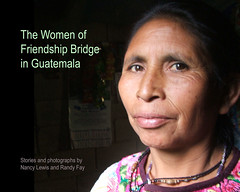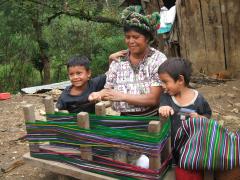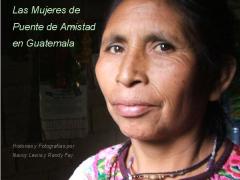Friendship Bridge
Volunteering for Kiva.org - A Major Change of Pace!
As we were riding through Mexico, we were really impacted by the poverty we saw, and became tremendously interested in the concept of microfinance, the practice of offering small loans ($100-$1000, usually), without requiring collateral, to tiny businesses. It turns out that last year's Nobel Peace Price winner, Mohammed Yunus, is the originator of the concept, and his book "Banker to the Poor" is tremendously inspiring. What they did with tiny, collateral-free loans in Bangladesh is the most hopeful story about alleviating poverty that I've ever heard in my life.
Nancy's Second Day of Interviews
Patti (the Friendship facilitator) and I hopped into the taxi (really the back of a pickup). We snaked our way along the shore and up the side of a mountain -- the view was incredible. As I looked across the emerald lake toward the towering volcanoes, I wondered how such a beautiful place could house such incredible poverty.
All day I sat with the Mayan women in their homes, business and community center learning about their struggles, victories and dreams.
These people had been living in a war-torn area for twenty years only to be further pummeled by the incredible natural disaster Hurricane Stan in 2005. The torrential rains as a result of the hurricane washed away many communities. Whole neighborhoods no longer exist because of the mudslides that swallowed up the land the neighborhood sat on and with it thousands of people. It threw these people further into grave poverty.
What we're doing in our daily work
During the week, we go to a village every morning and meet with one of the women who are the workhorses of Friendship Bridge, the "facilitators". These are the women who form the credit groups and know all of FB's clients. The facilitator will take us to one of more of the clients' homes and may stay with us or may deliver us over to the women. We then sit down and chat with as many as six or seven families, one at a time, about their business, their life, and what they're doing with their loan.
What is Microfinance Anyway?
The amazing man who won last year's (2006) Nobel Peace Prize pioneered the use of tiny loans without a requirement for collateral or security to poor people. Mohammed Yunus maintains with great success that if you just give poor people access to capital, they can make their own way in the world with their own businesses. His book, Banker to the Poor, is worth every minute of the time you take to read it - it's in every library and every bookstore and here on Amazon.com. It's the most hopeful book about poverty in the world that you will ever read. Yunus, with 25 years of experience in this, maintains that poor people pay off their loans at a much higher rate than the rich ones, and that simply providing capital in amounts like $100-$500 can transform the life of the poor by enabling them to start their own tiny businesses.
Women We've Met Recently
Last week Nancy met Clara Ajsoc in the highland village of Santa Clara La Laguna. Clara used her Friendship Bridge loan to buy a calf, which she raised, only to lose it to a sudden illness, leaving a young calf behind. But she bottlefed that one and raised it up successfully, and she now sells milk and cheese, where she had no livelihood before. And she wants to get another calf.
In San Antonio La Laguna, Nancy met Catarina Cox Perez, who lost her house to Hurricane Stan in October, 2005. She has been patching it back together bit by bit, but she lives in a really bad piece of broken house with no real windows, and she has to pile rocks up in the broken windowframes for a little privacy. But Catarina's big goal with her next loan is to buy and raise 24 chicks. More power to her. There's the great power of microfinance.
Podcast: What we're doing in Guatemala
We thought we'd explain to you what we're doing in Guatemala and tell you some of the stories of the women we've interviewed for Friendship Bridge and Kiva.org. We spend most of our time going out to little villages and meeting wonderful women who have started their own little "microbusinesses" using Friendship Bridge loans. The picture is of Clara Ajsoc, the wonderful woman we mention who raised her cow and started a milk and cheese business.
22:05 minutes (8 MB)
A Not-So-Good Interview in San Francisco Javier
Morning Road Near San Francisco Javier
This morning we woke up at 4am to catch a microbus from Nebaj, Quiche, Guatemala to interview a group of women in San Francisco Javier. The reason for the interview is to write the story of their business and lives in order to help obtain microloans on Kiva.org for Friendship Bridge in Guatemala. The rain was pouring as we made our way through the deep puddles of the dark streets. Only a few people were out at this time of the morning, walking in the rain underneath thin plastic sheets and clogging along in the total rubber boots so many of the campesinos wear in the fields. A few men hid in the shadows trying to stay dry or sobering up from the night's celebration. This week is the town's annual festival for its patron saint.
We got on the bus a little after 5am. It plowed out of town and followed a rough dirt road for about an hour. The darkness was made more intense by the low clouds that surround this incredible volcanic landscape. The morning light seeped though the misty morning. Clouds obscured most of the surrounding mountains but we got an occasional glimpse of the top of a-not-so distant volcano.
We wrote a little book: The Women of Friendship Bridge in Guatemala
Podcast: Friendship Bridge Women of Nebaj
We remember so very many women and have so many stories to tell from our time in Guatemala - we thought we'd just tell a few stories. Read on for lots of pictures and a slideshow of the women.
Maria Brito
To get to Maria Brito's house, we rode our bikes just up into the skirts of the valley where Nebaj is. As you leave the city (or town, really) you end up right away in green cornfields with people's houses scattered among them. Before long, you get to the end of the electricity lines, and well beyond the paved road, and end up on a muddy track headed up the hill. That's where Maria's house is. When we first met her, we thought "Oh, she's pretty poor" because she lived in a shack that she herself would not consider a house, with no electricity and with the water spigot across the road (at least she had one). But like many of the women we met, her dignity and friendliness transformed her right before our eyes from someone to be pitied into a woman to be honored, repected, and treasured.
42:58 minutes (8 MB)
Nuestro libro sobre Las Mujeres de Puente de Amistad en Guatemala
Hemos terminado la traducción a español de nuestro libro que trata de las increibles mujeres de Puente de Amistad, quienes conocimos trabajando en Guatemala en Junio y Julio del año pasado. Esas mujeres fueron tan impresionante y admirable. Por eso escribimos el libro, pero nunca tuvimos bastante tiempo para traducir a español y revisarlo. ¡Y las mujeres del libro nunca lo han visto! Pero en Quito pasamos casi una semana estudiando en el Cristóbal Colon Spanish School, y Randy tomó como su objetivo la traducción y revisión del este libro.
Usted puede leer el libro en forma PDF aquí. También es posible comprar una copia imprimida (a nuestro costo, sin ganancia) aquí en blurb.com. (Desfortunadamente no ofrecen pedidos a muchos paises, pero si a México y Argentina.)

